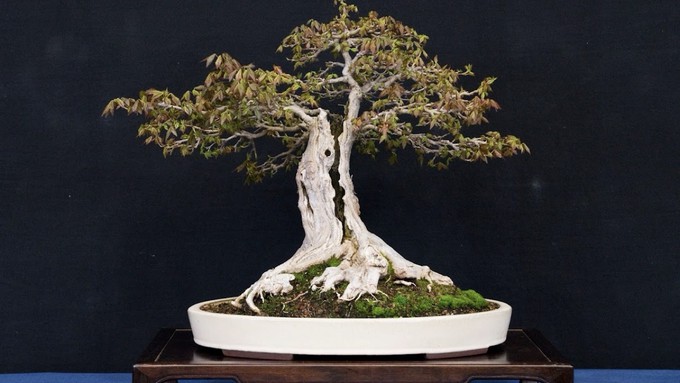
Two historic clubs host Sacramento events devoted to ancient tradition

This is just an example of the beautifully tended bonsai that will be on display this weekend at the Shepard Garden and Art Center. Photo courtesy American Bonsai Association, Sacramento
Do you love bonsai? You’re in the right place. Sacramento is home to two of the nation’s oldest bonsai clubs, each hosting a spring show and sale. That makes Sacramento the City of Little Trees.
Our seasonal salute to bonsai starts this weekend, April 8 and 9, with the 63rd annual spring show of the American Bonsai Association, Sacramento. A forest of little trees will fill the Shepard Garden and Arts Center in McKinley Park.
Show hours are 10 a.m. to 4 p.m. each day, with demonstrations by Colorado bonsai expert Todd Schlafer at 1:30 p.m. both days. Admission and parking are free.
A large sales area will be packed with little trees and plants appropriate for this hobby plus supplies such as appropriate containers, potting mix and gardening tools scaled to work on miniatures. Among the vendors will be Janette Bautista, Geoff Campbell, David Chimpky, Danny Power, Phil Richardson and Rick Savell. A consignment table features member-grown trees for sale as well as unique items for bonsai lovers.
Just starting bonsai? As part of this event, ABAS members will conduct a beginners workshop at 10 a.m. Sunday, April 10. For more information or to reserve a space, email absbonsaiclub@gmail.com.
Shepard Center is located at 3330 McKinley Blvd., Sacramento. Details: http://abasbonsai.org.
More than six decades ago, ABAS formed as an English-speaking offshoot of the original Sacramento Bonsai Club, the oldest bonsai club in the United States. With its early meetings conducted in Japanese, the Sacramento Bonsai Club was founded in 1946 by formerly interned Japanese Americans as a celebration of their culture. Nearly eight decades later, that original club is still going strong and still celebrating.
On May 6, the Sacramento Bonsai Club will host its 77th annual spring show at the Buddhist Church of Sacramento, 2401 Riverside Blvd., Sacramento. Show hours are 11 a.m. to 4 p.m. Admission is free.
This one-day show also features a plant and pot sale plus a raffle and refreshments. Learn the finer skills of bonsai during a 1:30 p.m. demonstration.
Details: http://www.sacbonsaiclub.com.
Comments
0 comments have been posted.Sacramento Digs Gardening to your inbox.
Food in My Back Yard Series
May 6: Maintain soil moisture with mulch for garden success
April 29: What's (already) wrong with my tomato plants?
April 22: Should you stock up on fertilizer? (Yes!)
April 15: Grow culinary herbs in containers
April 8: When to plant summer vegetables
April 1: Don't be fooled by these garden myths
March 25: Fertilizer tips: How to 'feed' your vegetables for healthy growth
March 18: Time to give vegetable seedlings some more space
March 11: Ways to win the fight against weeds
March 4: Potatoes from the garden
Feb. 25: Plant a fruit tree now -- for later
Feb. 18: How to squeeze more food into less space
Feb. 11: When to plant? Consider staggering your transplants
Feb. 4: Starting in seed starting
Sites We Like
Garden Checklist for week of May 11
Make the most of the lower temperatures early in the week. We’ll be back in the 80s by Thursday.
* Plant, plant, plant! It’s prime planting season in the Sacramento area. Time to set out those tomato transplants along with peppers and eggplants. Pinch off any flowers on new transplants to make them concentrate on establishing roots instead of setting premature fruit.
* Direct-seed melons, cucumbers, summer squash, corn, radishes, pumpkins and annual herbs such as basil.
* Harvest cabbage, lettuce, peas and green onions.
* In the flower garden, direct-seed sunflowers, cosmos, salvia, zinnias, marigolds, celosia and asters. (You also can transplant seedlings for many of the same flowers.)
* Plant dahlia tubers.
* Transplant petunias, marigolds and perennial flowers such as astilbe, columbine, coneflowers, coreopsis, dahlias, rudbeckia and verbena.
* Keep an eye out for slugs, snails, earwigs and aphids that want to dine on tender new growth.
* Feed summer bloomers with a balanced fertilizer.
* For continued bloom, cut off spent flowers on roses as well as other flowering plants.
* Add mulch to the garden to maintain moisture. Mulch also cuts down on weeds. But don’t let it mound around the stems or trunks of trees or shrubs. Leave about a 6-inch-to-1-foot circle to avoid crown rot or other problems.
* Remember to weed! Pull those nasties before they set seed.
* Water early in the day and keep seedlings evenly moist.